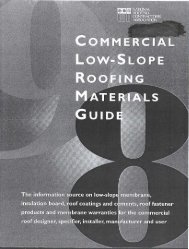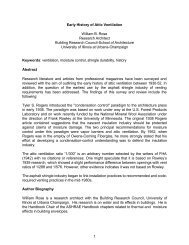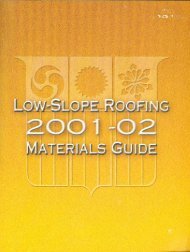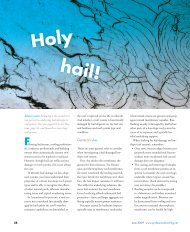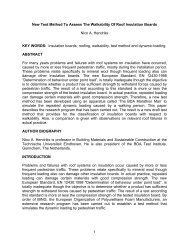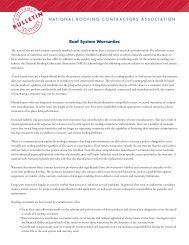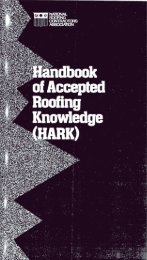- Page 2 and 3:
Roofing Materials GuideThe informat
- Page 4:
Table of Contents5 The Roofing Mate
- Page 7 and 8:
, '. figS only apply to tested asse
- Page 9 and 10:
How to Use the Roofing Materials Gu
- Page 11 and 12:
Section 1Roof Membranes
- Page 13 and 14:
I ndex to Listed ~ ~Roof Membranes
- Page 15 and 16:
Information on Roof MembranesBUILT-
- Page 17 and 18:
1 Th . k millimeters.. IC nessTh11
- Page 19 and 20:
,~- 19..ty of spanning joists witho
- Page 21 and 22:
Built-up RoofingGeneral information
- Page 23 and 24:
Built-up RoofingGeneral information
- Page 25 and 26:
Built-up RoofingGeneral information
- Page 27 and 28:
Built-up RoofingGeneral information
- Page 29 and 30:
,. , -I IBuilt-up RoofingGeneral in
- Page 31 and 32:
.-- 31'.Built-up RoofingGeneral inf
- Page 33 and 34:
.,.?~f~~c-Built-up RoofingGeneral i
- Page 35 and 36:
Built-up RoofingGeneral information
- Page 37 and 38:
Built-up RoofingGeneral information
- Page 39 and 40:
Built-up RoofingGeneral information
- Page 41:
Built-up Roofing -General informati
- Page 44 and 45:
Modified Bitumen and Elastomeric/Pl
- Page 46 and 47:
PRODUCT NAME COMPANY NAME APPLICABL
- Page 48 and 49:
Modified Bitumen Part 1: General In
- Page 50 and 51:
Modified Bitumen Part 1: General In
- Page 52 and 53:
Modified Bitumen Part 1: General In
- Page 54 and 55:
Modified Bitumen Part 1: General In
- Page 56 and 57:
Modified Bitumen Part 1: General In
- Page 58 and 59:
Modified Bitumen Part 1: General In
- Page 60 and 61:
Modified Bitumen Part 1: General In
- Page 62 and 63:
Modified Bitumen Part 1: General In
- Page 64 and 65:
Modified Bitumen Part 1: General In
- Page 66 and 67:
Modified Bitumen Part 1: General In
- Page 68 and 69:
Modified Bitumen Part 1: General In
- Page 70 and 71:
Modified Bitumen Part 2: Test Resul
- Page 72 and 73:
Modified Bitumen Part 2: Test Resul
- Page 74 and 75:
Modified Bitumen Part 2: Test Resul
- Page 76 and 77:
~Modified Bitumen Part 2: Test Resu
- Page 78 and 79:
Modified Bitumen Part 2: Test Resul
- Page 80 and 81:
Modified Bitumen Part 2: Test Resul
- Page 82 and 83:
Modified Bitumen Part 2: Test Resul
- Page 84 and 85:
Modified Bitumen Part 2: Test Resul
- Page 86 and 87:
Modified Bitumen Part 2: Test Resul
- Page 88 and 89:
Modified Bitumen Part 2: Test Resul
- Page 90 and 91:
Modified Bitumen Part 2: Test Resul
- Page 92 and 93:
.Modi1iedTest DescriptionBitumen Pa
- Page 94 and 95:
Modified Bitumen Part 2: Test Resul
- Page 96 and 97:
Modified Bitumen Part 2: Test Resul
- Page 98 and 99:
-Modified Bitumen Part 2: Test Resu
- Page 100 and 101:
Modified Bitumen Part 2: Test Resul
- Page 102 and 103:
Modified Bitumen Part 2: Test Resul
- Page 104 and 105:
Modified Bitumen Part 3: Modified B
- Page 106 and 107:
Modified Bitumen Part 3: Modified B
- Page 108 and 109:
Modified Bitumen Part 3: Modified B
- Page 110:
Modified Bitumen Part 3: Modified B
- Page 113 and 114:
Modified Bitumen Part 3: Modified B
- Page 115 and 116:
-'-'-" --~ --,,--,. - ,-Modified Bi
- Page 117 and 118:
_.Modified Bitumen Part 3: Modified
- Page 119 and 120:
- --- -- -~- -- ~.,Modified Bitumen
- Page 121 and 122:
-- - --""'"Modified Bitumen Part 3:
- Page 123 and 124:
no.:'.:' Type of Sub.t.t. Spo".I;on
- Page 125 and 126:
PVC Part 1: General Information1. C
- Page 127 and 128:
PVC Part 2: Test ResultsTest descri
- Page 129 and 130:
EPDM Part 1: General Information1.
- Page 131 and 132:
EPDM Part 1: General Information1.
- Page 133 and 134:
,-EPDM Part 1: General Information1
- Page 135 and 136:
EPDM Part 1: General Information1.
- Page 137 and 138:
EPDM Part 1: General Information1.
- Page 139 and 140:
EPDM Part 1: General InformationSTA
- Page 141 and 142:
EPDM Part 2: Test ResultsTest descr
- Page 143 and 144:
_C""""'---~-"" - , ,-- .- - ~~,EPDM
- Page 145 and 146:
_..~_., ~_c,","-~,~~~ ~._"-, - -. ,
- Page 147 and 148:
Neoprene lPolychloroprene)Part 2: T
- Page 149 and 150:
~-.~""",;,,""--'---'-""-'--~ ~._'.'
- Page 151 and 152:
._',:1:'cCSPE (Hypalon) Part 2: Tes
- Page 153 and 154:
,~,Pia (Polyisobutylene)Part 2: Tes
- Page 155 and 156:
-'-"- --",-."0CPE (ChlorinatedPolye
- Page 157 and 158:
-"~ .,Other Prefabricated Sheet-App
- Page 159 and 160:
,,!,-Other Prefabricated Sheet-Appl
- Page 161 and 162:
Other Prefabricated Sheet-AppliedUN
- Page 163 and 164:
--"Metal Roof PanelsAllied Roof sys
- Page 165 and 166:
._,~-,.~,. ,- -'- -Metal Roof Panel
- Page 167 and 168:
Metal Roof PanelsAmerican Buildings
- Page 169 and 170:
Metal Roof Panels -ASC Pacific, Inc
- Page 171 and 172:
Metal Roof PanelsAtlas Aluni Corpor
- Page 173 and 174:
Height(s) \ : SeM SealantMetal Roof
- Page 175 and 176:
Height(s) I ~ Se. SealantMetal Roof
- Page 177 and 178:
Metal Roof Panels -. .Bui lding Tec
- Page 179 and 180:
."-~:~. -" '~."-_.~-, ,-Metal Roof
- Page 181 and 182:
.¥,j'Metal Roof PanelsIPS Insulate
- Page 183 and 184:
Height(s) I ' Se~ SealantMetal Roof
- Page 185 and 186:
Height(s) I ~ Se~ SealantMetal Roof
- Page 187 and 188:
Metal Roof PanelsFABRAL-Alcan Build
- Page 189 and 190:
~~ !~~~~~_! ~~ !~~~~~_! ~~ !~~~~~_!
- Page 191 and 192:
Metal Roof PanelsGeorge D. Wicillan
- Page 193 and 194:
Metal Roof PanelsIlnlaoo Buildings
- Page 195 and 196:
Metal RoofPanelsNBCI NBCI NBCIUltra
- Page 197 and 198:
Metal Roof PanelsMBC. NBC. MBC.Craf
- Page 199 and 200:
Metal Roof PanelsMcElroy Metal I~.
- Page 201 and 202:
Metal Roof PanelsMerchant & Evans,
- Page 203 and 204:
Metal Roof PanelsMerchant & Evans,
- Page 205 and 206:
Height(s) I : Seam SealantMetal Roo
- Page 207 and 208:
Se~He~ght(s) I! Se~ sealan~ I He!gh
- Page 209 and 210:
Metal Roof Panels. . .United Steel
- Page 211 and 212:
Metal Roof PanelsVincent Metals I/e
- Page 213 and 214:
.,."in method of application includ
- Page 215 and 216:
,~18. OWFRS CORNING FlBERG~Modified
- Page 217 and 218:
0_- ,,-,-, '--'-' ,- - .Section 2'"
- Page 219 and 220:
NOTE If he ,I;'d O lde ,I;' ial or
- Page 221 and 222:
" provalmanufacturer issuing guaran
- Page 223 and 224:
.fih Id bI ro Ing systems s ou e pu
- Page 226 and 227:
!21.,~o0~"O~5E"~"O2:'i: ~.; .e_~~ .
- Page 228 and 229:
I .QI .."E~S1O"E;"~-6":;:;-=££.!!
- Page 230 and 231:
I- ~ =-- -., ,8 """'1 ""~ - ~ == "~
- Page 232 and 233:
.-?;- OC - - c 0OI~"O~\aJL LLLLa. a
- Page 234 and 235:
U;t-;'""::l:U;N:l:N:l:U;N:I:~:I:0=G
- Page 236 and 237:
ln-.-..c;"C .E "C 10 '" I .~~c ~- ,
- Page 238 and 239:
.~e0I ~~I;: ~ QI ~EO~'"O~E' g = m2!
- Page 240 and 241:
I II~~~8~->-."'~~cC:-£~$0---0 Q)""
- Page 242 and 243:
" , , "," ," I~ ~fJ"c E >-~ c»~5~=
- Page 244 and 245:
"""-"-'.'--" - "_.. ."'- _.,._"c._.
- Page 246 and 247:
.. .- -- .- e ,- ~ ~ C tUQI >- ,~-"
- Page 248 and 249:
'-"" .. '-"-" ,,--, .-.".- --. ...
- Page 250 and 251:
-~ ~ N c? .: Iti (Q r-.: ICES ai d
- Page 252 and 253:
"22 ~~=;3S:~ ~sg,~. ~~~,"!-"'~ ~9.~
- Page 254 and 255:
I ~AI j.~I "g-" ..- .-, .-- - "--'.
- Page 256 and 257:
Ii---, ,--- ~~~---, c.Ioj ~Uc ~ ' >
- Page 258 and 259:
I ;I1 .0lit) Ig~ -G) - .c -' G).'-.
- Page 260 and 261:
I 0I'- - " ". - - ,. ,' '---'~'-'-'
- Page 262 and 263:
.. 'UI(\1-- ~ ~-~ ' : .c~-~ .v.- ~
- Page 264 and 265:
'" Uc- c- 0) 0) 0) a. "'0 CO)- -"'0
- Page 266 and 267:
~~~ w U~ C ~=E E -8.g~"8~~= :!:;'~
- Page 268 and 269:
~~~u:0.~.8,., -~ ~- .- ' I \t;;'!:~
- Page 270 and 271:
o..!.-. 0 E ~' OQ)~"'.S1n ~;E~ '6~$
- Page 272 and 273:
~"'6~~'-~~-5-, ~ '".- ... a.'I~~ C
- Page 274 and 275:
.,.-.. 0 = ,0 "0 -UI ~C Q) "'~'- UI
- Page 276 and 277:
.:. -"" .I ~", 'lJ~c- c - - ~.- ~..
- Page 278 and 279:
~~I 'llQ ' ~ "-
- Page 280 and 281:
~, ' "' I., t wEll, ,- " cE"UIm .t.
- Page 282 and 283:
~~.SQ)1O~1 _>-02EC),O.c.:~a.a>a>0 I
- Page 284 and 285:
.91-(J0 , . ~ ~ ~-"0 C') cO; j ~ .Q
- Page 286 and 287:
~ C to - -.-1 Q)..9..~~£~ ~ Q) ~ Q
- Page 288 and 289:
"0lU'-.!. .. .8 C Q) Q) ., .-.,.c .
- Page 290 and 291:
lOE~.. ~ .N ~p !O !D ~ !" S" ""!,,
- Page 292 and 293:
~ m~.:.0~, "2 "0 6 'C ~~ -EC: ~ ~ j
- Page 294 and 295:
~.5I c'0..-l u"0::>tG~5~"(ij.2"0" "
- Page 296 and 297:
'"I0~~'"E:c~"'!~sQI.~~cEz;-.-:5:;10
- Page 298 and 299:
~ "'-In~O~ U~1n -g ,-Q)~ :00;.Q) Q)
- Page 300:
~,ga>0)8U~:E-.-~U0==-g6 '.-0)0)'O)~
- Page 304 and 305:
m-aI - -, 0 Q)- . >-- > [ ICO "C 0"
- Page 306 and 307:
8 c1t:::> ~"Ccci > a;~Q)(/)~~Q) .o"
- Page 308 and 309:
1/11, . > !;4~!,'i¥j !Q) E I > - "
- Page 310 and 311:
E CO1 0 - 0 uiui};.::O c..2S 0"~ ";
- Page 312 and 313:
:5"E0"C-..'- .c 0 '"'" 0 g "E g E .
- Page 314 and 315:
~ "0 ~ .0 ,._-0"E.~~>-m ,~"D ~ - -I
- Page 316 and 317:
1 .5o..!. ch c .6 I E 0) .u-0 > 0 0
- Page 318 and 319:
, 0~ 'e: !O. I ~ ~.- .~ ." 0= 0 IG
- Page 321 and 322:
., -Oa)"-,,~5g5 .,IU~., 0 ~1U1I:~E-
- Page 323 and 324:
~'"- iSE co"", .. "' 8 '::" .!., ,
- Page 325 and 326:
01:0 I:U)~ -01:-.- u.. .c:J ~!i~ U)
- Page 327 and 328:
.,.l~ > - ,- .~ ::J .0 E .'-Q)° C
- Page 329 and 330:
~ " 0 cO. --C~ ,!2., _.o,,~u;"'c1;;
- Page 331 and 332:
1 '0U.iI ~1 0!i clU1U~ ~0) .C'"~ ~0
- Page 333 and 334:
~ Q)' ~c~ .£:' '" 0 ~...£: - §Ec
- Page 335 and 336:
I 0> UJ ~:.0;:J..1;c.~.cQ.!5Q.""".c
- Page 337 and 338:
=0) ,I/)!!J.NC o.. ' C O--O-'~ C Q)
- Page 339 and 340:
I d,~Q)~Uu~ u .-Cl~."" E'6~I: I:~ -
- Page 341 and 342: ...0~C~ =>-'" Co-~ ,.'" ~"' ~ ~ --
- Page 344 and 345: i"m-I:"" 0 - I: ~E I:~.. --~ 0 ~,..
- Page 346 and 347: - tOtO ~ 0 ~ 0 ~Q).- ~)(Q) 0 ...' Q
- Page 349 and 350: Section 3Roof Board Insulation
- Page 351 and 352: Index to Listed RoofBoard Insulatio
- Page 353 and 354: PerlitePerlitic roof board insulati
- Page 355 and 356: 367Expanded PolystyreneRoof Board I
- Page 357 and 358: Extruded PolystyreneRoof Board Insu
- Page 359 and 360: Extruded PolystyreneRoof Board Insu
- Page 361 and 362: Glass Fiber/Mineral FiberRoof Board
- Page 363 and 364: 375FiberboardRoof Board Insulation(
- Page 365 and 366: FiberboardRoof Board Insulation(Hom
- Page 367 and 368: PerliteRoof Board Insulation(Homoge
- Page 369 and 370: PolyisocyanurateRoof Board Insulati
- Page 371 and 372: Polyisocyan u rateRoof Board Insula
- Page 373 and 374: CompositeRoof Board Insulation1. Co
- Page 375 and 376: CompositeRoof Board InsulationBRANC
- Page 377 and 378: CompositeRoof Board InsulationOIVER
- Page 379 and 380: CompositeRoof Board InsulationGREAT
- Page 381 and 382: CompositeRoof Board InsulationWESTE
- Page 383 and 384: same high R-value polyiso core, and
- Page 385 and 386: drainage, sufficient to drain roof
- Page 387 and 388: PANDA: Nord Bitumi's new PANDA roof
- Page 389 and 390: 401provided in the unit. All panel
- Page 391: ~ 153Index to Listed J ~ J ~Roof Fa
- Page 395 and 396: Roof Fasteners: Steel Decks1. Compa
- Page 397 and 398: Column 1 Column 2 D.I60 1 5/8 1 1/8
- Page 399 and 400: Roof Fasteners: Steel Decks1. Compa
- Page 401 and 402: Roof Fasteners: Steel Decks1. Compa
- Page 403 and 404: Roof Fasteners: Steel Decks1. Compa
- Page 405 and 406: Roof Fasteners: Steel Decks1. Compa
- Page 407 and 408: Roof Fasteners: Steel Decks1. Compa
- Page 409 and 410: --Roof Fasteners: Steel Decks1. Com
- Page 411 and 412: -~Roo! Fasteners: Steel Decks-----T
- Page 413 and 414: 427Roof Fasteners: Steel DecksTRU-
- Page 415 and 416: Roof Fasteners: Wood DecksTHE CELOT
- Page 417 and 418: 431Roof Fasteners:CONSTRUCTII* FAST
- Page 419 and 420: ~Roof Fasteners: Wood DecksDURD LAS
- Page 421 and 422: Roof Fasteners: Wood DecksFABCO RIF
- Page 423 and 424: 437Roof Fasteners: Wood DecksGAf BU
- Page 425 and 426: 439Roof Fasteners: Wood DecksHILTI
- Page 427 and 428: 441Roof Fasteners: Wood DecksITW BU
- Page 429 and 430: IRoof Fasteners:Wood DecksNATIC*AL
- Page 432 and 433: Roof Fasteners: Wood Decks1. Compen
- Page 434 and 435: .51 Plata Shape, Dimensions, and Ma
- Page 436 and 437: Roof Fasteners: Wood Decks1. Compan
- Page 438 and 439: .51 Plate Shape, Dimensions, and Ma
- Page 440 and 441: Roof Fasteners: Concrete Decks1. Co
- Page 442 and 443:
.51 Plata Shape, Dimensions, and M8
- Page 444 and 445:
.51 Plate Shape, Dimensions, and Ma
- Page 446 and 447:
Roof Fasteners: Concrete Decks1. Co
- Page 448 and 449:
Roof Fasteners: Concrete Decks1. Co
- Page 450 and 451:
Roof Fasteners: Concrete Decks1. Co
- Page 452 and 453:
w_" 466Roof Fasteners: Lightweight
- Page 454 and 455:
468Roof Fasteners: Lightweight Conc
- Page 456 and 457:
.61 Plate ShaP8, Dimensions, and Ma
- Page 458 and 459:
Roof Fasteners: Lightweight Concret
- Page 460 and 461:
IRoof Fasteners: Lightweight Concre
- Page 462 and 463:
476Roof Fasteners: Lightweight Conc
- Page 464 and 465:
Appendix,Roof FastenersThe informat
- Page 466:
,..


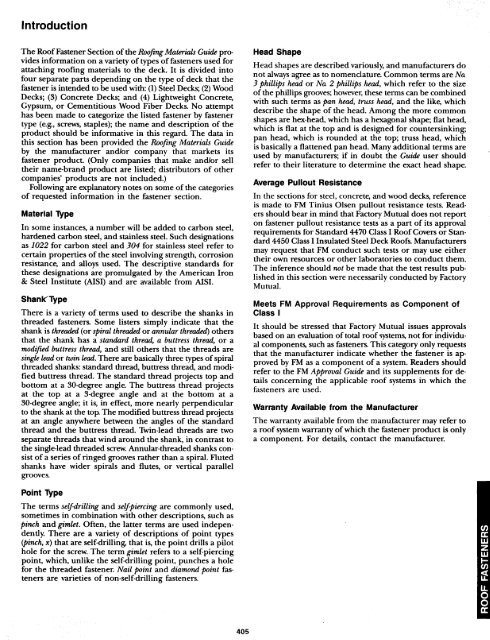

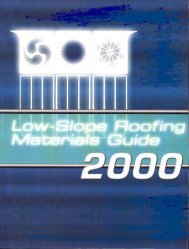
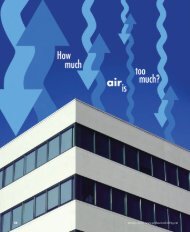

![Wm] - National Roofing Contractors Association](https://img.yumpu.com/36696816/1/190x245/wm-national-roofing-contractors-association.jpg?quality=85)

